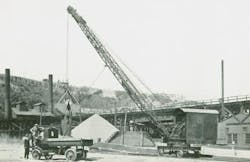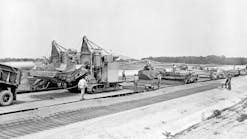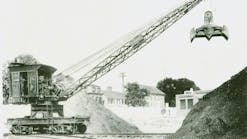Industrial Works of Bay City, Mich., entered the railroad equipment market in 1881 with an innovative but unsuccessful type of railroad shovel. In 1883, the company produced the first steam railroad wrecking crane commercially manufactured in America (following one built by a Michigan railroad in its own shops). This was a half-swing machine of 20-ton capacity. Also in 1883, it introduced a 4-ton capacity, pedestal-mounted, full-revolving wharf crane for dockside use. These cranes were powered by independent boilers.
Until 1886, most railroad cranes consisted of a hand-operated pedestal crane on a flatcar, and the few self-propelled railroad cranes, dubbed locomotive cranes, in America had been imported from England. That was the year that Industrial Works mounted an improved steam wharf crane on a four-wheeled flatcar for use around their plant. Later that same year, they introduced the first true locomotive crane to be built in America. This was a 15-ton capacity machine with the boiler at the opposite end of the frame from a full-revolving boom.
For the next two decades, Industrial Works focused on designing and building many types of railroad and industrial cranes, along with pile drivers and hammers, clamshell buckets, railroad transfer tables, and rail saws. In a precursor to today’s intermodal container services, the Transfer Crane—a bridge crane designed for transferring cargo—was marketed in 1923 for handling less-than-carload freight containers between railroad cars and trucks.
Industrial Works’ locomotive cranes, railroad wreckers, and pile drivers were well-respected and reliable, and these products became their “bread-and-butter” lines. Until the advent of the truck crane, locomotive cranes were the only mobile cranes of any respectable size that were available for general construction use. They could be found on railroad spurs and sidings, loading or unloading equipment, supplies and construction materials. They trundled about large aggregate plants, cement mills and quarries, loading product for delivery by rail, and they clammed aggregates into batch plants situated at trackside for convenient delivery of dry materials. They trod cautiously on lightweight, temporary track and trestles as they handled everything from excavation and pile driving to steel erection and concrete pours at bridges, dams, locks and buildings.
In 1927, Industrial Works merged with the Brown Hoisting Machinery Co., and a new company, Industrial Brownhoist Corp., was established with headquarters in Bay City. Industrial Brownhoist continued to be successful in the railroad crane business and also produced cable excavators and cranes, dockside and industrial cranes, trenchers, and other material handling equipment. By 1950, the company boasted it had built “more than 20,000 cranes of all types.”
Business fell off after World War II, and Industrial Brownhoist was sold to the Penn-Texas Corp. in 1954; five years later it was sold again, to a hotel group based in Miami Beach, Fla. Business continued to fade, and in 1960 the American Hoist & Derrick Co. of St. Paul, Minn., purchased what remained: a plant with only about 40 employees. Its new life as American’s Industrial Brownhoist Division reinvigorated the plant for a couple of decades before it was shut down for good in 1983.
The Historical Construction Equipment Association (HCEA) is a 501(c)3 nonprofit organization dedicated to preserving the history of the construction, dredging and surface mining equipment industries. With more than 4,000 members in 25 countries, activities include operation of National Construction Equipment Museum and archives in Bowling Green, Ohio; publication of a quarterly magazine, Equipment Echoes, from which this text is adapted, and hosting an annual working exhibition of restored construction equipment. Individual memberships are $30 within the U.S. and Canada, and $40 elsewhere. Information is available at www.hcea.net, 419.352.5616, or [email protected].





